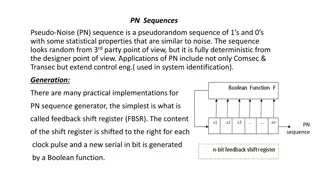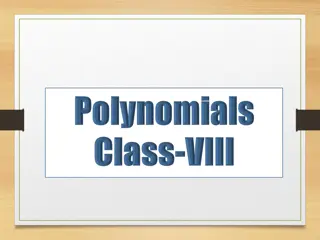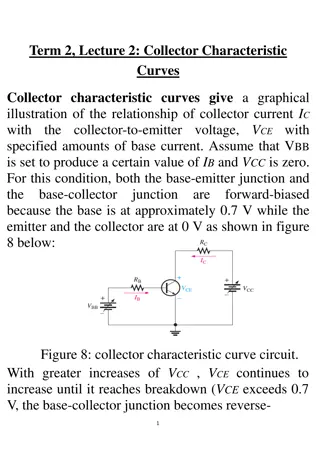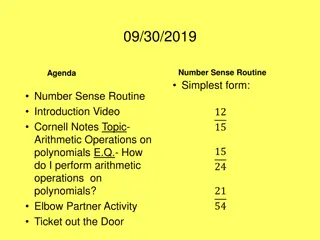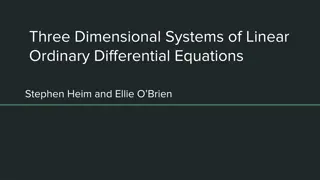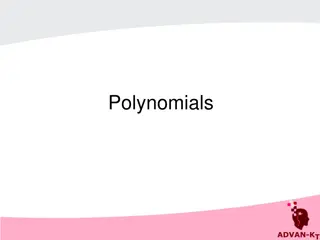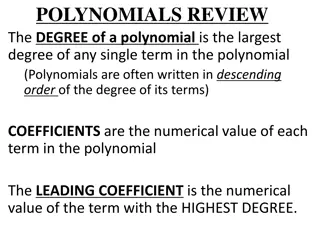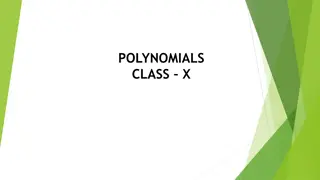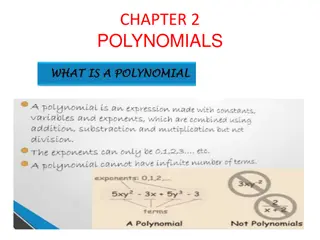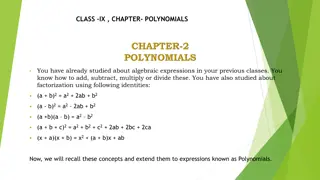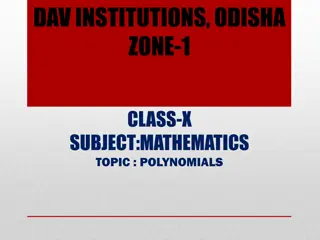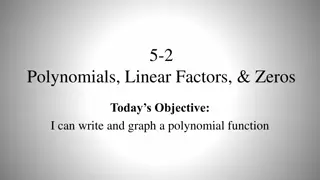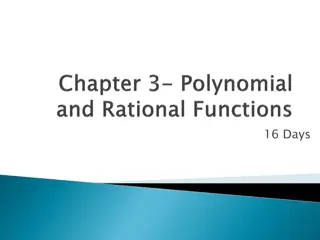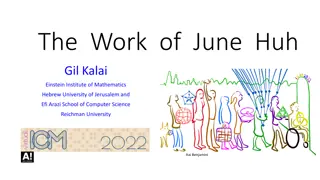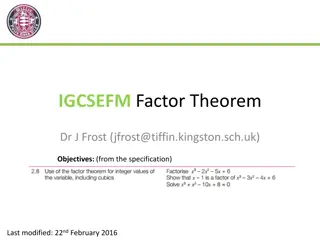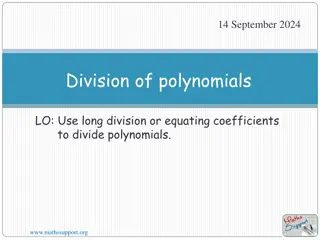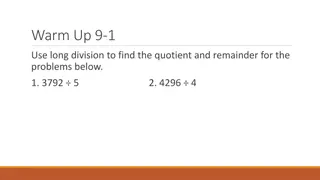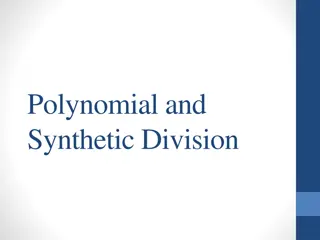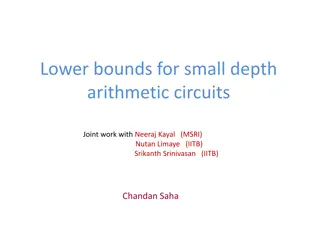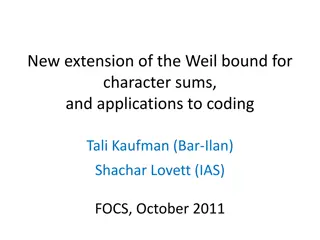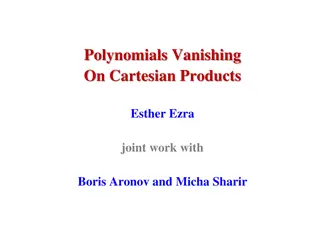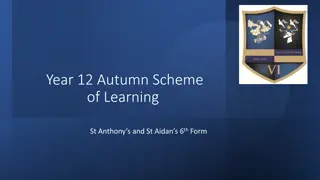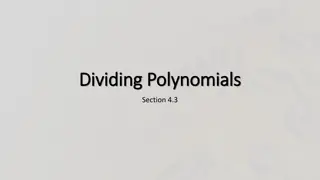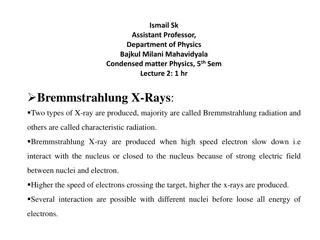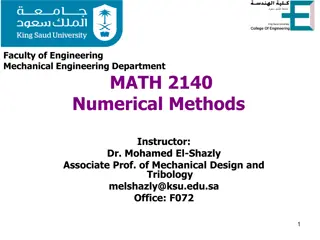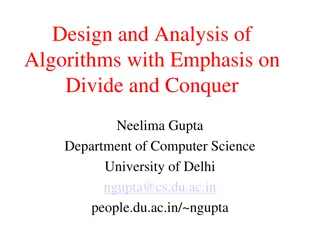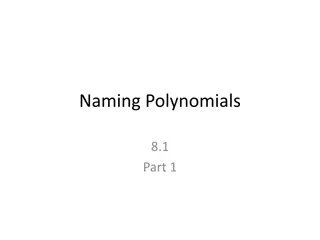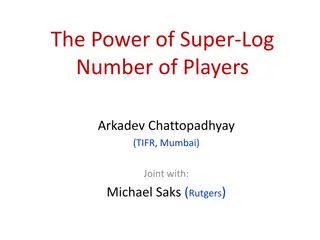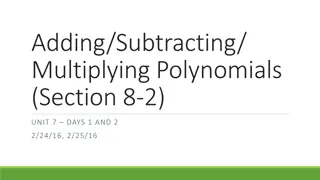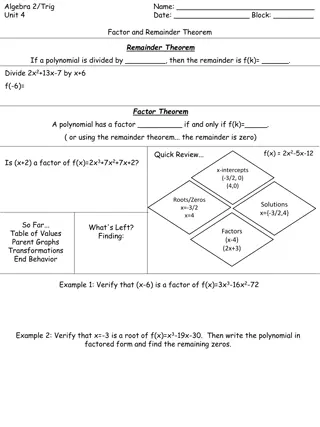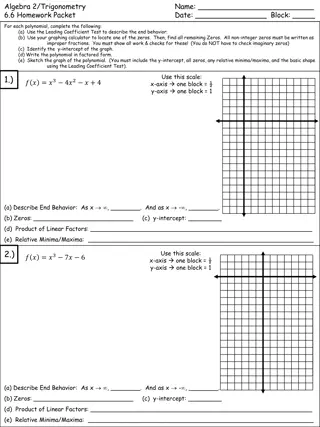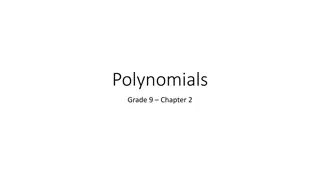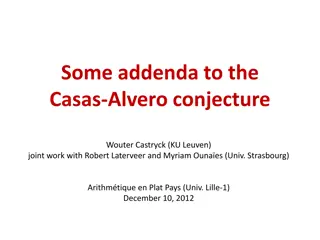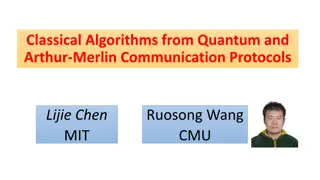Galois Theory and Field Extensions
Explore the fundamental concepts of Galois theory, field automorphisms, prime subfields, and field extensions. Learn how symmetries and polynomials play a crucial role in creating new mathematical objects, and understand the significance of field extensions in adjoining roots of polynomials. Delve i
1 views • 14 slides
Pseudo-Noise Sequences and Applications
Pseudo-Noise (PN) sequences are deterministic yet appear random, with applications in various fields such as communication security, control engineering, and system identification. Generated using shift registers, they exhibit statistical properties akin to noise. Linear and nonlinear feedback shift
2 views • 19 slides
Item Characteristic Curve Presentation by Chong Ho Alex Yu
Presentation slides showcasing the item characteristic curve by Chong Ho and Alex Yu. The slides contain detailed information and visuals related to the curve, providing a comprehensive overview of its characteristics and analysis. Each slide presents key insights and data points in a visually engag
0 views • 37 slides
Polynomial Basics: Definitions, Classification, and Operations
Learn the fundamentals of polynomials, including defining polynomials, determining degrees, classifying by terms, writing in standard form, and performing operations like multiplication and division. Understand monomials, binomials, trinomials, coefficients, and degrees of polynomials in a straightf
2 views • 36 slides
Transistor Operation through Collector Characteristic Curves
Collector characteristic curves provide insight into the transistor's operation in various regions such as cutoff, saturation, and active. By analyzing the relationship between collector current (IC) and collector-to-emitter voltage (VCE) with base current variations, one can understand how a transi
0 views • 7 slides
Introduction to Arithmetic Operations on Polynomials
This unit focuses on developing an understanding of polynomials in mathematical expressions. You will learn about the parts of a polynomial, polynomial operations, and representing polynomials. The topics cover performing arithmetic operations on polynomials, identifying variables in expressions, le
1 views • 71 slides
Three-Dimensional Systems of Linear Ordinary Differential Equations
Explore the concepts of three-dimensional linear systems of ordinary differential equations, including techniques for finding eigenvalues and the general solutions. Learn how to determine characteristic polynomials for 3x3 matrices and identify sink, source, and saddle points in 3D systems.
0 views • 20 slides
Polynomial Functions and Operations
Polynomial functions are mathematical functions in the form of an expression involving variables and coefficients. They can be manipulated through operations like addition, subtraction, multiplication, and division. Learn about polynomial degrees, identifying polynomials, and performing various oper
0 views • 20 slides
Polynomials: Degrees, Coefficients, and Graphs
Explore the essential concepts of polynomials, including degrees, coefficients, and graph shapes. Learn to identify leading coefficients, degrees, and relationships between polynomial functions and their graphs. Practice finding values of polynomials and analyzing the impact of degrees on the number
3 views • 16 slides
Polynomials and Their Zeroes: A Comprehensive Overview
Explore the world of polynomials, from linear to quadratic to cubic, and understand the concept of degrees, zeroes, and their geometrical meanings. Learn how to determine the value of polynomials at specific points and find the zeroes of different types of polynomials through clear examples and expl
0 views • 14 slides
Polynomials: Types, Degrees, and Zeroes
Polynomial expressions consist of terms with non-zero coefficients. They can have any number of terms and different degrees. Linear polynomials have a degree of one, quadratic polynomials have a degree of two, and cubic polynomials have a degree of three. Zeroes of a polynomial are the values of the
0 views • 17 slides
Polynomials and Algebraic Expressions
Dive into the world of algebraic expressions and polynomials, exploring concepts like constants, variables, coefficients, and degrees. Learn how to identify terms, understand polynomial types based on degrees, and solve related mathematical problems.
0 views • 12 slides
Polynomials in Mathematics
Explore the concept of polynomials in mathematics, including the geometrical meaning of zeroes, the relationship between zeroes and coefficients, and the division algorithm. Learn about the degree of polynomials, value of polynomials, and how to identify and factorize them. Discover algebraic expres
1 views • 46 slides
Football Review Questions and Challenges
Explore a variety of challenging football-themed questions covering topics such as geometry, algebra, and taxes. Test your skills with questions on dimensions, equations, polynomials, geometric sequences, and more. Get ready to score big with these stimulating brain teasers!
1 views • 37 slides
Eigenvalues and Characteristic Polynomials
Unravel the mystery of eigenvalues and characteristic polynomials through detailed lectures and examples by Hung-yi Lee. Learn how to find eigenvalues, eigenvectors, and eigenspaces, and explore the roots of characteristic polynomials to solve characteristic equations. Dive into examples to discover
2 views • 19 slides
Polynomials: Zeros, Factors, and Graphs
Understanding polynomials, linear factors, and zeros. Learn how to write and graph polynomial functions, find roots and x-intercepts, apply the Factor Theorem, and plot graphs using zeros and end behaviors.
0 views • 4 slides
Polynomials and Graphs through Real-World Analogies
Explore the relationship between mountain ranges and polynomials, and learn how to apply the Intermediate Value Theorem to find zeros of polynomial functions. This guide covers concepts like the Interval Value Theorem, sketching graphs of higher-degree polynomials, and constructing tables to analyze
3 views • 85 slides
Insights into Graph Colorings, Chromatic Polynomials, and Conjectures in Discrete Geometry
Delve into the fascinating world of graph colorings, chromatic polynomials, and notable conjectures in discrete geometry. Explore the impact of June Huh in bringing Hodge theory to combinatorics and his proof of various mathematical conjectures. Uncover the significance of the four-color theorem, co
0 views • 17 slides
Division of Polynomials using Remainder and Factor Theorem
Explore the concept of dividing polynomials to find remainders and factors, illustrated through examples and explanations. Learn how to apply the Remainder and Factor Theorem to determine remainders, factors, and solve related problems. Test your understanding with practical questions.
0 views • 17 slides
Polynomial Division Methods and Examples
Dividing polynomials involves using methods like long division or equating coefficients. By applying these techniques, you can determine whether a polynomial divides exactly or leaves a remainder. The process is similar to long division of numbers, where the dividend is divided by the divisor to obt
0 views • 10 slides
Polynomial Division and Remainder Theorems Explained
Learn how to use long division to find quotients and remainders in polynomial problems. Understand when to use long division or synthetic division. Discover how the remainder theorem works by finding remainders when dividing specific polynomials by different factors. Explore the factor theorem and i
0 views • 6 slides
Polynomial and Synthetic Division Techniques
Learn how to perform polynomial division using long division and synthetic division methods. Understand how to divide polynomials by other polynomials or binomials, utilize the Remainder Theorem and Factor Theorem, and apply these concepts through detailed examples.
0 views • 41 slides
Care Experience as a Protected Characteristic
Protected characteristics are aspects of one's identity safeguarded by law to prevent unfair treatment based on traits like age, disability, and sex. Addressing discrimination faced by care leavers is crucial, as they often encounter stigma and lack of understanding in various settings. Making care
0 views • 5 slides
Factorization Methods and Factor Tables in Mathematics
Explore the techniques of factorization through Tic-Tac-Toe method and factor tables. Learn how to find pairs of numbers that multiply to a given result, factor polynomials correctly, and understand the importance of factoring in mathematics concepts. Engage with visual representations and step-by-s
0 views • 12 slides
Lower Bounds for Small Depth Arithmetic Circuits
This work explores lower bounds for small-depth arithmetic circuits, jointly conducted by researchers from MSRI, IITB, and experts in the field. They investigate the complexity of multivariate polynomials in arithmetic circuits, discussing circuit depth, size, and the quest for an explicit family of
0 views • 114 slides
New Extension of the Weil Bound for Character Sums
Tali Kaufman and Shachar Lovett present a new extension of the Weil bound for character sums, providing applications to coding theory. The Weil bound offers insights into the behavior of low-degree polynomials, distinguishing between structured and random-like functions. This extension has implicati
0 views • 28 slides
Insights into Polynomials Vanishing on Cartesian Products and the 3POL Problem
This joint work explores polynomials vanishing on Cartesian products, focusing on the 3POL problem involving three sets of points and a 6-variate polynomial. It discusses the running time of solving the explicit 3POL problem and compares it to the well-studied 3SUM problem in theoretical computer sc
0 views • 29 slides
Year 12 Autumn Scheme of Learning for St. Anthony's and St. Aidan's 6th Form
Explore the comprehensive Year 12 Autumn Scheme of Learning for St. Anthony's and St. Aidan's 6th Form, covering topics such as algebraic manipulation, quadratic equations, simultaneous equations, graphs, statistical sampling, differentiation, integration, and statistical hypothesis testing. Dive in
1 views • 13 slides
Polynomial Division Methods
Learn how to divide polynomials using long division and synthetic division techniques. Explore the processes of dividing polynomials by other polynomials or binomials, using the Remainder Theorem, and applying synthetic division to evaluate polynomials. Master the steps with detailed examples and vi
0 views • 14 slides
Bremmstrahlung and Characteristic X-Rays in Condensed Matter Physics
In condensed matter physics, Bremmstrahlung X-rays and characteristic X-rays are produced through different interactions of high-speed electrons with nuclei in target atoms. Bremmstrahlung radiation is generated when electrons slow down near the nucleus, while characteristic radiation is produced wh
0 views • 5 slides
Newton's Interpolating Polynomials in Mechanical Engineering
Explore Newton's interpolating polynomials in the context of Mechanical Engineering, specifically focusing on numerical methods and interpolation techniques. Dr. Mohamed El-Shazly, an Associate Professor of Mechanical Design and Tribology, guides students through the concepts and applications of New
0 views • 17 slides
Algorithms Design and Analysis with Divide and Conquer Approach
Explore the intricacies of algorithm design and analysis, with a focus on divide and conquer techniques. Delve into topics such as iterative and recursive algorithms, writing summations, divide and conquer strategy, and more. Discover how to compute large numbers, polynomials, perform searching and
1 views • 15 slides
Polynomials: Types and Naming Conventions
Delve into the world of polynomials with definitions, examples, and explanations of how they are named based on the number of terms they contain. Learn about monomials, binomials, trinomials, and general polynomials, along with insightful images to aid your understanding.
0 views • 33 slides
Advanced Complexity Conjectures on Protocol Design
Explore advanced complexity conjectures and protocol designs in the realm of computational theory, discussing topics such as the power of super-log number of players, block composition, low-degree polynomials, and polynomial fantasies. Delve into the complexities of MAJ.MAJ, SYM, and more, while con
0 views • 12 slides
Polynomials Operations: Adding, Subtracting, Multiplying - Unit 7 Days 1 and 2
Dive into the world of polynomial operations in this engaging unit covering adding, subtracting, and multiplying polynomials. Explore methods to combine like terms, distribute negative signs, and apply polynomial operations to solve problems. Practice sorting gumballs with like terms and creating nu
0 views • 23 slides
Polynomial Factor and Remainder Theorems
Exploring the Factor and Remainder Theorems in algebra, including examples on verifying factors, finding roots, applying the Rational Root Test, and determining zeros of polynomials. Learn how to factor polynomials, find remaining zeros, and analyze coefficients to uncover the complete factorization
0 views • 6 slides
Polynomial Analysis Homework Packet
Complete polynomial analysis including end behavior description, locating zeros, finding y-intercepts, factoring, and sketching graphs for given polynomials in a homework packet. Utilize the leading coefficient test and graphing calculator to identify zeros and graph features accurately.
0 views • 4 slides
Zeroes of Polynomials - Grade 9 Chapter 2
Zeroes of a polynomial are the values of the variable that make the polynomial equal to zero. This concept is explored in Grade 9 Chapter 2, where students learn how to find the zeroes of a polynomial by equating it to zero. Through examples like p(x) = x - 4, students understand how to determine th
0 views • 10 slides
Addenda to Casas-Alvero Conjecture: Polynomial Derivatives and Common Roots.
In this research work, the Casas-Alvero conjecture is explored, focusing on polynomials and their derivatives, and the common roots they share. The study delves into the normalization of roots under various transformations, using p-adic methods and Gröbner bases. Noteworthy findings include implica
0 views • 24 slides
Classical Algorithms from Quantum and Arthur-Merlin Communication Protocols
Explore the Polynomial Method in classical algorithms, focusing on Orthogonal Vectors, All-Pair-Shortest-Path, and Approximate Closest Pair. Learn how the Polynomial Method works through batch evaluation for multi-variable polynomials and fast matrix multiplication. Discover insights on low-rank dec
0 views • 13 slides

